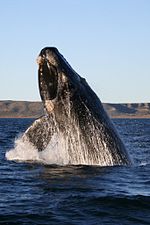Search results
Appearance
There is a page named "Diunatans" on Wikipedia
- emerge"). Diunatans was around the size of the living minke whale. Several distinguishing characteristics can be seen in the skull of Diunatans, including...3 KB (276 words) - 19:46, 7 May 2023
- novaeangliae †Archaebalaenoptera †Archaeschrichtius †Cetotheriophanes †Diunatans †Eschrichtioides †Gricetoides †Incakujira †Miobalaenoptera †Nehalaennia...17 KB (1,808 words) - 04:40, 29 April 2024
- †Archaebalaenoptera †Archaeschrichtius Balaenoptera †Burtinopsis? †Cetoteriophanes †Diunatans †Eschrichtioides Eschrichtius †Gricetoides †Incakujira Megaptera †Megapteropsis...73 KB (7,580 words) - 15:36, 28 June 2024
- †Archaebalaenoptera †Archaeschrichtius Balaenoptera †Burtinopsis? †Cetoteriophanes †Diunatans †Eschrichtioides Eschrichtius †Gricetoides †Incakujira Megaptera †Megapteropsis...63 KB (7,046 words) - 01:08, 14 June 2024
- †Archaebalaenoptera †Archaeschrichtius Balaenoptera †Burtinopsis? †Cetoteriophanes †Diunatans †Eschrichtioides Eschrichtius †Gricetoides †Incakujira Megaptera †Megapteropsis...19 KB (2,436 words) - 16:14, 11 April 2024
- †Archaebalaenoptera †Archaeschrichtius Balaenoptera †Burtinopsis? †Cetoteriophanes †Diunatans †Eschrichtioides Eschrichtius †Gricetoides †Incakujira Megaptera †Megapteropsis...11 KB (1,040 words) - 14:36, 2 May 2024
- †Archaebalaenoptera †Archaeschrichtius Balaenoptera †Burtinopsis? †Cetoteriophanes †Diunatans †Eschrichtioides Eschrichtius †Gricetoides †Incakujira Megaptera †Megapteropsis...1 KB (59 words) - 05:43, 29 December 2023
- †Archaebalaenoptera †Archaeschrichtius Balaenoptera †Burtinopsis? †Cetoteriophanes †Diunatans †Eschrichtioides Eschrichtius †Gricetoides †Incakujira Megaptera †Megapteropsis...11 KB (1,029 words) - 21:27, 11 April 2024
- †Archaeschrichtius Balaenoptera †Burtinopsis (nomen dubium) †Cetotheriophanes †Diunatans †Eschrichtioides Eschrichtius – gray whales †Gricetoides Megaptera – humpback...116 KB (12,778 words) - 22:31, 2 May 2024
- †Archaebalaenoptera †Archaeschrichtius Balaenoptera †Burtinopsis? †Cetoteriophanes †Diunatans †Eschrichtioides Eschrichtius †Gricetoides †Incakujira Megaptera †Megapteropsis...4 KB (417 words) - 06:01, 9 February 2024
- †Archaebalaenoptera †Archaeschrichtius Balaenoptera †Burtinopsis? †Cetoteriophanes †Diunatans †Eschrichtioides Eschrichtius †Gricetoides †Incakujira Megaptera †Megapteropsis...1 KB (64 words) - 14:44, 16 October 2021
- †Archaebalaenoptera †Archaeschrichtius Balaenoptera †Burtinopsis? †Cetoteriophanes †Diunatans †Eschrichtioides Eschrichtius †Gricetoides †Incakujira Megaptera †Megapteropsis...8 KB (695 words) - 21:59, 10 May 2024
- †Archaebalaenoptera †Archaeschrichtius Balaenoptera †Burtinopsis? †Cetoteriophanes †Diunatans †Eschrichtioides Eschrichtius †Gricetoides †Incakujira Megaptera †Megapteropsis...2 KB (128 words) - 06:03, 9 February 2024
- †Archaebalaenoptera †Archaeschrichtius Balaenoptera †Burtinopsis? †Cetoteriophanes †Diunatans †Eschrichtioides Eschrichtius †Gricetoides †Incakujira Megaptera †Megapteropsis...11 KB (1,199 words) - 14:14, 9 November 2023
- †Archaebalaenoptera †Archaeschrichtius Balaenoptera †Burtinopsis? †Cetoteriophanes †Diunatans †Eschrichtioides Eschrichtius †Gricetoides †Incakujira Megaptera †Megapteropsis...12 KB (974 words) - 06:23, 13 May 2024
- †Archaebalaenoptera †Archaeschrichtius Balaenoptera †Burtinopsis? †Cetoteriophanes †Diunatans †Eschrichtioides Eschrichtius †Gricetoides †Incakujira Megaptera †Megapteropsis...3 KB (319 words) - 19:13, 14 April 2024
- †Archaebalaenoptera †Archaeschrichtius Balaenoptera †Burtinopsis? †Cetoteriophanes †Diunatans †Eschrichtioides Eschrichtius †Gricetoides †Incakujira Megaptera †Megapteropsis...3 KB (266 words) - 01:23, 22 August 2022
- †Archaebalaenoptera †Archaeschrichtius Balaenoptera †Burtinopsis? †Cetoteriophanes †Diunatans †Eschrichtioides Eschrichtius †Gricetoides †Incakujira Megaptera †Megapteropsis...3 KB (250 words) - 00:26, 25 February 2022
- †Archaebalaenoptera †Archaeschrichtius Balaenoptera †Burtinopsis? †Cetoteriophanes †Diunatans †Eschrichtioides Eschrichtius †Gricetoides †Incakujira Megaptera †Megapteropsis...3 KB (256 words) - 06:54, 28 June 2024
- †Archaebalaenoptera †Archaeschrichtius Balaenoptera †Burtinopsis? †Cetoteriophanes †Diunatans †Eschrichtioides Eschrichtius †Gricetoides †Incakujira Megaptera †Megapteropsis...9 KB (687 words) - 05:58, 9 February 2024
















